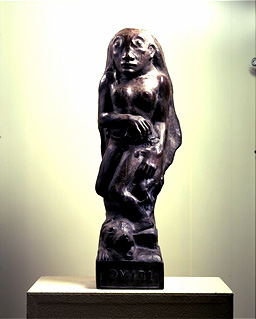
Development of the human-body sculptures
After Rodin
 Japanese Japanese  |

| Rodin had put life again into the 19th century sculptures that were almost fading, with his power of observation, strong expression, and unique sense of muscle and flesh.
He had become a major artist among sculptors of his and the following period.
Rodin's pupil Claudel, created personal and indoor sculptures that were totally opposite from public monuments. An assistant, Bourdelle gradually became independent from Rodin by pursuing more solid form of art. Maillol displayed abstract theme with soft and smooth woman body. German sculptor, Lehmbruk added soul into naked body as he eliminated more sense of flesh than Maillol did. Another German sculptor, Barlach also expressed natural spirit that derived from oridanary people in everyday lives. Rosso treated surface of sculptures different from those of Rodin,and established a new sense of quality. In the beginning of the 20th century, non-European civilization had surfaced and many artists apparently took this new form, as Brancusi, Gauguin, Giacometti and Moore. However, they were still conscious about Rodin art which had inherited traditional European style of sculpture. Meanwhile, the theme of 'Space'that Rodin struggled with his work, 'The Gates to Hell' had reached a solution by 'Space of sculpture' created by Archipenko and Lipchitz. Objects analyzed by surface and vacancy, not by volume, indicated that reality of modern human beings that could only be understood by the theory of relativity. |
[ Works at Rodin Wing ]
[Development of Post-Rodin Sculpture] |
 List of Works at Rodin Wing List of Works at Rodin Wing 
|
 The 19th Century French Sculpture Before Rodin(At Rodin Wing) The 19th Century French Sculpture Before Rodin(At Rodin Wing) 
|
 Audio commentary Audio commentary 
|
 Copyright (c) 2004 Shizuoka Prefectural Museum of Art
Copyright (c) 2004 Shizuoka Prefectural Museum of Art